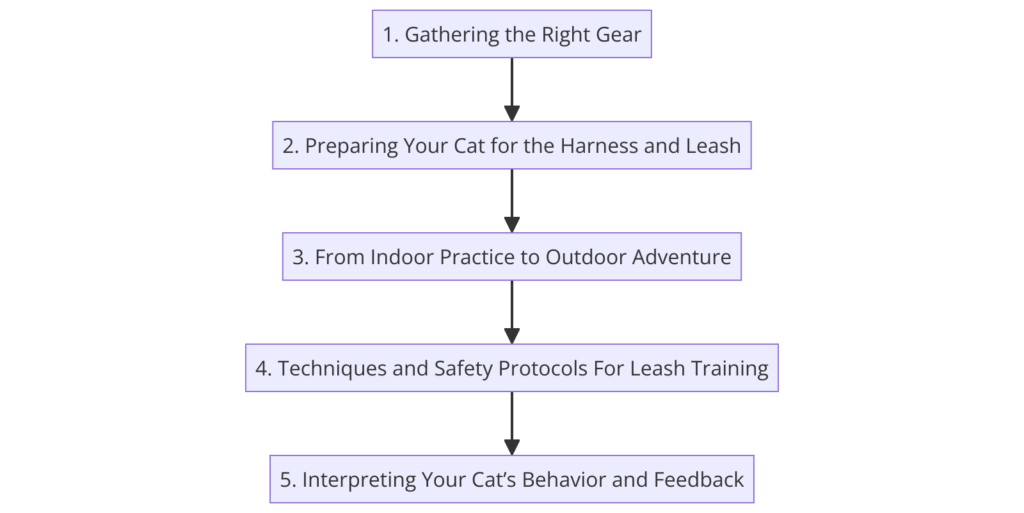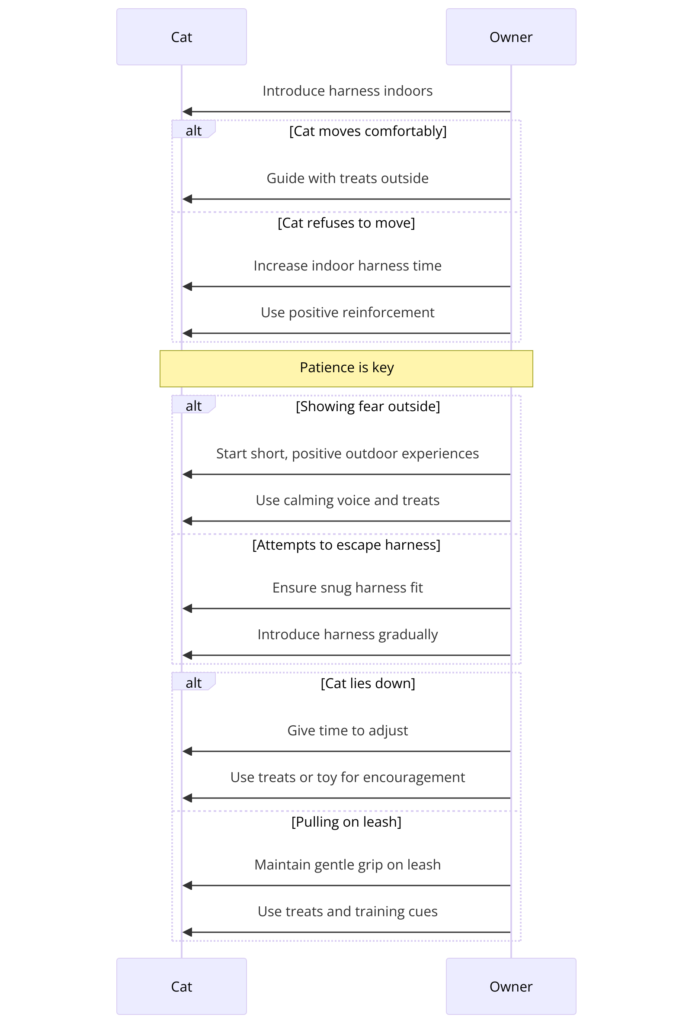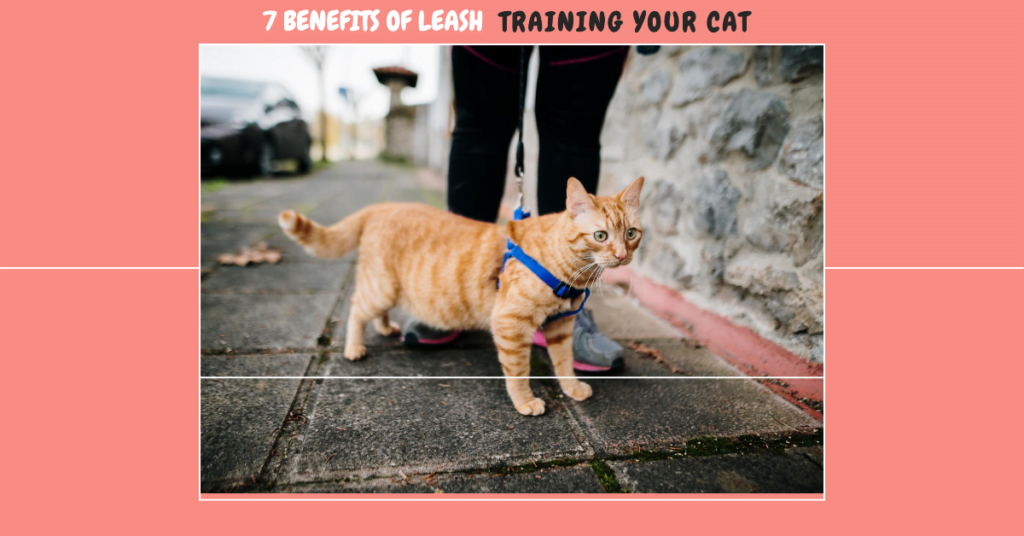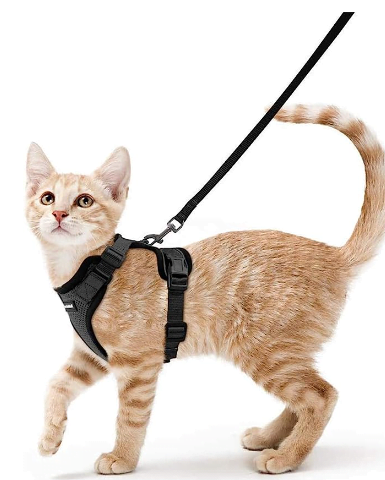This post contains affiliate links and I will be compensated if you make a purchase after clicking on my links.
Starting Your Leash Training Adventure
Leash training your cat can open a world of adventures and benefits for both you and your furry companion.
But it’s not without its challenges. I remember the first time I attempted to leash train my cat—I enthusiastically used my dog’s harness, only to watch in dismay as my cat frantically dashed, leaving one of my mum’s favorite vases in pieces. This misadventure taught me an important lesson: cats are not small dogs, and they require a tailored approach to leash training.

In this guide, we’ll walk you through on how to leash train a cat and provide a step-by-step approach to ensure you get it right, keeping both your feline’s curiosity satisfied and your home decor intact.
Understanding the Benefits of Leash Training
Leash training is a way to significantly enrich your cat’s daily life. It offers vital benefits, reducing the risks associated with unsupervised roaming.
Beyond safety, the mental and physical stimulation it provides helps combat boredom and promotes a healthier lifestyle for indoor cats, offering them a controlled taste of the wild under your supervision.
Step-By-Step Guide on How To Leash Train a Cat

Step 1: Gathering the Right Gear for Leash Training
Choosing the Perfect Harness
Begin with a harness that’s specifically designed for cats, ensuring a snug and comfortable fit without limiting their mobility. Choosing a proper cat harness is essential for secure and enjoyable adventures, preventing escapes while avoiding any discomfort. Avoid using a dog harness, as I learned, since it won’t cater to a cat’s unique size and shape.
Selecting the Ideal Leash
The right leash is crucial. Lightweight and flexible options work best, providing your cat with the freedom to explore while still being securely tethered.
Pro Tip: Consider a bungee-style leash for added flexibility, which is particularly useful for absorbing any sudden movements from your cat.
Preparing Healthy, Delicious Treats
Treats and toys are invaluable for positive reinforcement during the training process. They encourage your cat to engage with the training, making each step feel like a rewarding game.
Make sure to be equipped with healthy cat treats
Step 2: Preparing Your Cat for the Harness and Leash

Health Check and Preventive Care
Before taking the first steps outside, ensure your cat is ready for the adventure. This involves vet check-ups to confirm physical fitness, as well as making sure all vaccinations are up to date and preventive treatments against fleas, ticks, and heart worms are administered.
Introduce Harness
Introduce the harness to your cat within a positive and calm environment. Allow them to inspect it and become accustomed at their own pace. Place the harness on them, starting with just a few minutes at a time, and gradually extend the duration bit by bit. Repeat this process daily until your cat seems comfortable wearing the harness. Provide treats to your cat only when they are wearing the harness, reinforcing a positive association with it.
Leash Introduction
Begin by attaching the leash to the harness and allowing your cat to drag it around. This helps them get used to the feel of the leash without any pressure. Gradual familiarization is key to building comfort and trust.
Step 3: From Indoor Practice to Outdoor Adventure

Starting Leash Training Indoors
Begin your leash training journey indoors, where the environment is controlled and familiar to your cat. This stage is about letting your cat take the lead and explore at their own pace. The goal here is to build confidence and comfort with the harness and leash setup in a safe space.
Gradually Introducing Your Cat to the Outdoors
When you feel your cat is ready, gradually transition to the outdoors. The initial outdoor experience should be positive and controlled. Choose a quiet, enclosed area to minimize distractions and potential stressors, ensuring a positive introduction to the outside world.
Maintaining Regular Outings
Regular outings are crucial for reinforcing training and building confidence. Each outing enhancing your cat’s adaptability and enjoyment of the outdoors. Consistency is key to maintaining progress and ensuring your cat’s outdoor experiences remain enjoyable and stress-free.
Step 4: Techniques and Safety Protocols For Leash Training
Positive Reinforcement
Always use positive reinforcement to encourage desirable behavior during leash training. Rewarding your cat for good behavior with treats, praise, or play reinforces their positive associations with the harness, leash, and the act of exploring outdoors.
Security and Comfort with the Harness
When buying a harness, accurately measure your cat’s neck and chest girth to ensure a proper fit. Harnesses vary in size to match different cat body shapes.

Before purchasing a cat leash, consult a size chart like this for guidance
Carrier for Safe Transport
Utilize a carrier for vet visits or when introducing your cat to a new outdoor location; it’s about ensuring safety and preparedness for any situation.
Step 5: Interpreting Your Cat’s Behavior and Feedback
Understanding Your Cat’s Body Language
Paying attention to your cat’s body language is vital for a successful leash training experience. This helps you understand their comfort levels and stress signals. This understanding allows you to adjust your approach, ensuring each outing is enjoyable and beneficial for your cat.
Overcoming Challenges in Cat Leash Training
After introducing the basics of leash training your cat and ensuring you’ve got the right gear and approach, you might still face a few roadblocks along the way.
Cats, like people, have their unique personalities and comfort zones, which means the path to successful leash training can sometimes include a few bumps. Let’s address some common issues and how to navigate them.

Issue 1: Cat Refuses to Move
Patience is key. If your cat refuses to move, it may indicate discomfort or uncertainty about the harness or the outdoor environment. Start by increasing harness familiarization time indoors, pairing it with positive reinforcements like treats or play. Once your cat moves comfortably indoors with the harness, try guiding them with treats outside, taking small steps and offering lots of praise.
Issue 2: Showing Fear Outside
Begin with short, positive outdoor experiences in a quiet, secure area to minimize fear triggers. Use a calming voice and treats to reassure your cat. Consider using a cat-specific pheromone spray on the harness or carrier to help reduce anxiety. Gradually increase the time spent outside as your cat becomes more comfortable.
Issue 3: Attempting to Escape the Harness
Ensure the harness fits well; it should be snug, not tight. Introduce the harness gradually, allowing your cat to wear it for short periods indoors, slowly increasing the time. Monitor your cat’s behavior for signs of discomfort or distress, adjusting as necessary.
Issue 4: Cat Lies Down and Refuses to Continue Walking
If your cat suddenly stops and lies down, they may be feeling overwhelmed or need a break. Don’t force them to move; instead, give them some time to adjust and observe their surroundings. You can encourage them to move with treats or a favorite toy, but patience is crucial. Try to identify any specific triggers that cause this behavior and work on desensitizing them through gradual exposure.
Issue 5: Pulling on the Leash
If your cat pulls on the leash, they might be trying to explore too quickly or escape from something that scares them. Maintain a gentle but firm grip on the leash and don’t allow them to lead you. Training your cat to respond to cues, such as coming when called, can also help manage this behavior.
Conclusion: Charting the Success of How to Leash Train a Cat
It’s clear that leash training your cat is a fusion of time-honored pet care practices with a dash of contemporary flair. This journey offers more than just safety for your cat—it’s an invitation to shared outdoor adventures that many cat owners only dream of. Now that we’ve laid out the steps, it’s time to move from theory to practice. Begin by assembling your toolkit: find that perfect harness, select the right leash, and stock up on treats for positive reinforcement.
Leash walking your cat makes you one of the select few confidently exploring the world with a cat by your side. Remember, while you may draw curious glances, you’re also pioneering a shift towards a more adventurous, fulfilling life for indoor cats.
Meet Sean, a fintech whiz with a penchant for pet purrs and blockchain buzz. After a decade of fintech feats, Sean's tech talents leaped from ledger lines to litter lines, driven by a passion for pets and a vision for a more connected pet care community. With three critter companions as co-pilots, Sean launched this blog to share a treasury of pet-friendly tech tips and tales.





